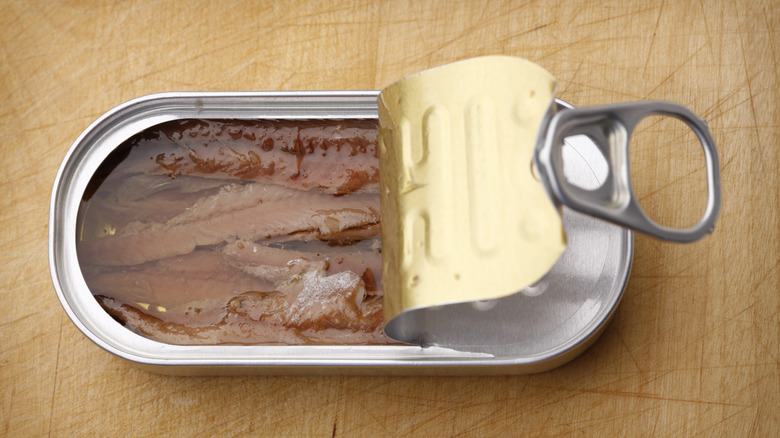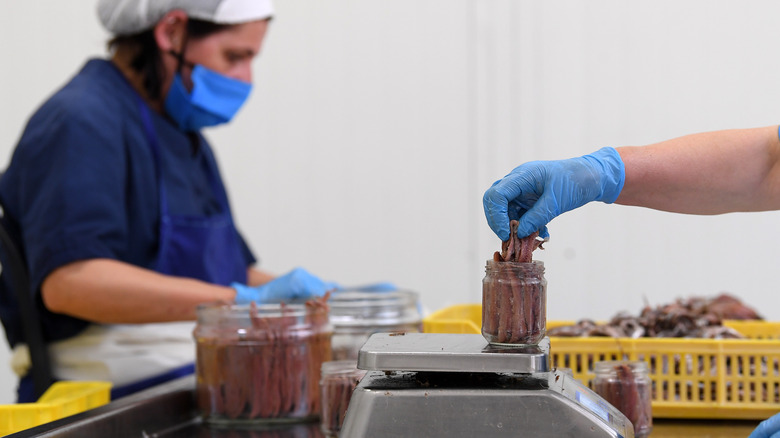Never Have Mushy Canned Anchovies Again With Just One Easy Step
We're going to make the strong assumption that because you're reading this, you like your tinned fish. And if you're an anchovy appreciator, we're going to make your life better in one easy step: Put them in your refrigerator. Done. You're welcome.
Now, what did you just do that for? Most importantly, you slowed microbial activity. As Iker Fernández of Ortiz Anchovies told Anna Hezel, author of "Tin to Table," anchovies aren't preserved the same as many other foods. They aren't cooked — just simply brined in a saline solution and then packed. The salt does a great job of preserving in a food-safe way, preventing bacterial and mold growth, but microbes will still be present. These microbes can lead to the meat of the anchovy becoming soft and, well, mushy. But by keeping them in the refrigerator, you can stave off this process. And if you're sensitive to particularly fishy tastes and smells, good news: According to the owner of Brooklyn's Mercado Central, Zhana Londoner, it's this deterioration that's to blame for the worst of it. Properly stored anchovies should be a briny, savory flavor bomb, but shouldn't knock you out with fishiness, necessarily.
Proper temperatures and handling for anchovies
Many anchovies in Europe, where the fish are a common and staple snack, are stored in chilled cases. Though AnchoasDeluxe, a specialty shop based out of Guarnizo, Spain, is adamant that all anchovies must be kept cold– including the canned ones. But in America, where anchovies are often used as an ingredient to melt into Caesar salad dressings and puttanesca sauces — or at best, a controversial pizza topping — they're most commonly seen on grocery shelves that aren't temperature controlled. This is probably okay, explains Dan Wabar of Rainbow Tomatoes Garden. As long as the store has decent turnover, the tins aren't going to be sitting there for so long that they'll deteriorate. Forgotten in the back of your top cabinet shelf, though, is a different story.
Crown Prince, a producer of tinned fish and seafood, details good anchovy handling practices: Refrigerated, their anchovies — which are packed just before shipping — will last for a good 18 months unopened, no problem. If your cans are starting to puff, they warn that this is more likely due to improper storage than improper canning; the naturally occurring microbes are creating a gas that's bloating the can. Because anchovies are not cooked prior to canning and shipping, proper storage is required. Hezel points out that certain brands recommend storage temperatures of 41 to 50 degrees Fahrenheit. The slightly cooler temps of your fridge certainly won't hurt.
How to eat anchovies
Now that you know the fatal flaw you've been making with anchovies, it's time to bust out a new tin and give them another fair shot. If you already like anchovies, this might be a revelation. If you don't like anchovies, these might just make you reconsider.
If you want to ease into the brined fish game, take cues from famed cured fish lovers the Scandinavians. Generously butter rye bread (or sourdough), drape a filet over it and dig in. The strong flavors of the bread and the mellow fattiness of the butter will balance the fish while still letting the bacon of the sea shine.
You can add them to sandwiches like the chaotic French pan bagnat, which takes all of the toppings of a niçoise salad and throws them between some bread. Wet bread haters beware, the whole purpose of this sandwich is to get soggy (the name literally means bathed bread). You could also make anchoïade, an anchovy pate of sorts, to eat on crackers or as a sandwich spread.
And if you're ready to give them a try all on their own but not quite willing to scoop them right out of the can with your fingers, sauté a few of them in a hit of hot olive oil with garlic, red pepper flakes, parsley, white wine, and lemon juice. Eat with a fork, on garlic-rubbed toast, or over pasta to really appreciate the firm texture of your refrigerated anchovies.


